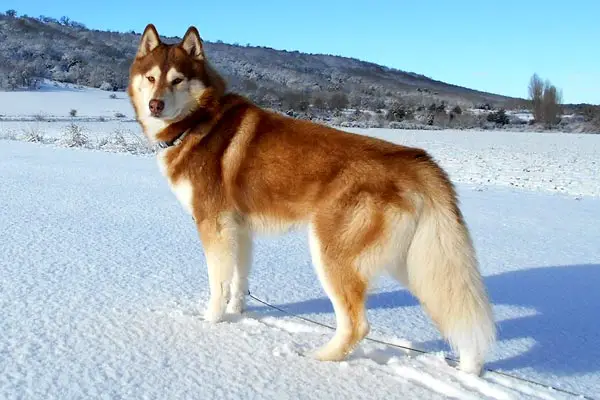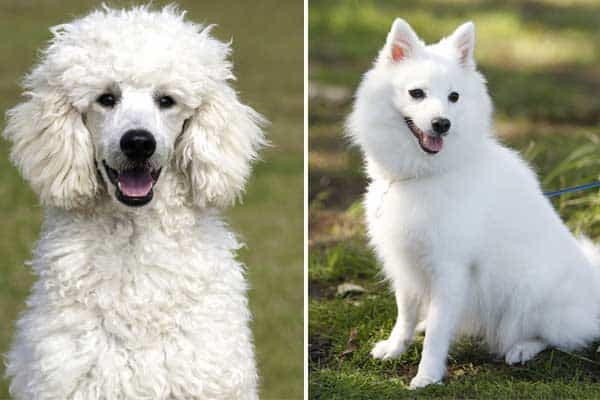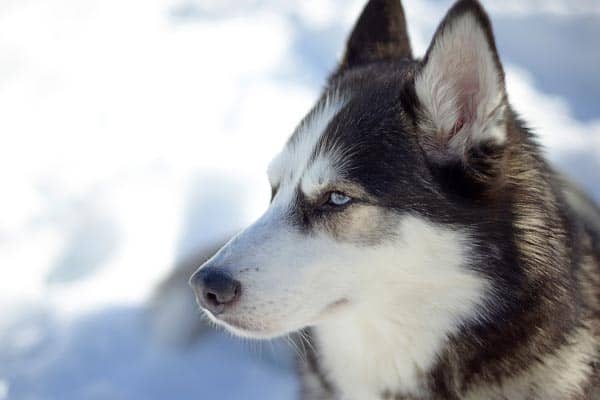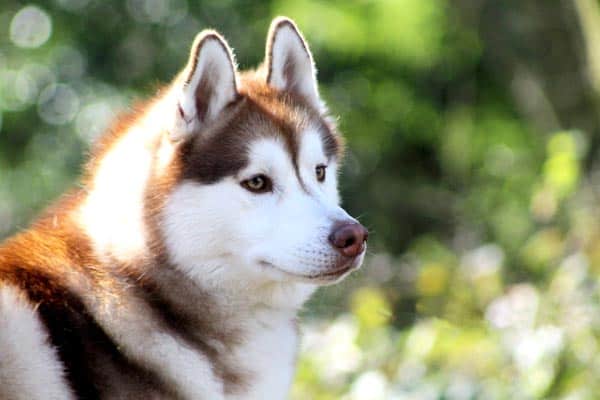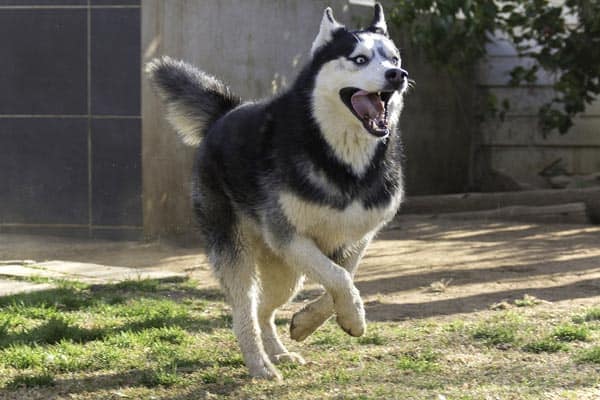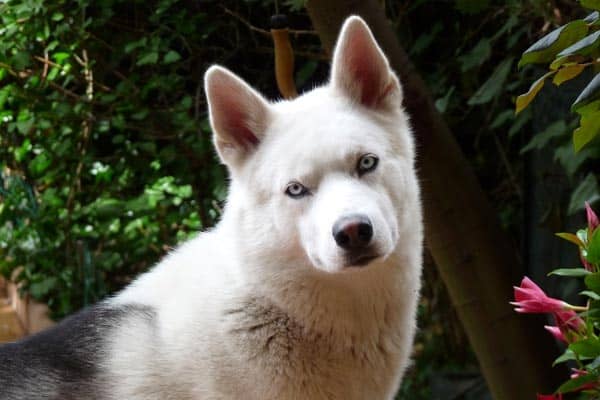Japanese Spitz Siberian Husky Mix: Not for the House or Hauling Sleds
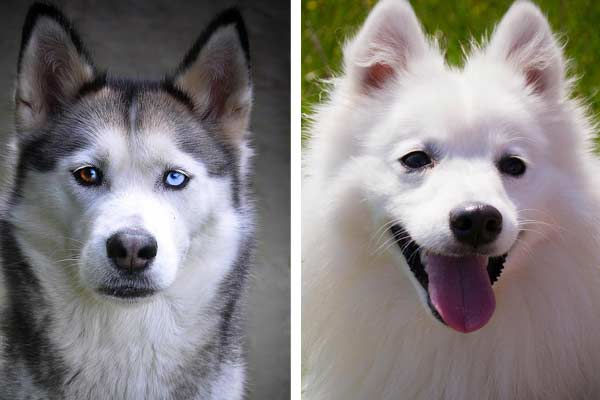
Siberian Husky mixes are popular. First, they are abundant because so many people want them.
Second, they are escape artists and thus have many opportunities to mingle with dogs they encounter on their ventures.
Third, dog lovers want Husky hybrids to enhance another dog’s beauty or temper their own breed’s unbridled enthusiasm and intensity. Do you get either of these things when you mix your Husky with a Japanese Spitz?
A Japanese Spitz Siberian Husky mix creates a unique dog combining the traits of two breeds that belong to the same family. While the Spitz is a companion and the Husky is a sled racer, the hybrid brings a working dog’s proud bearing, athleticism, and high energy.
Japanese Spitz Husky mixes are also loving and loyal and excellent with children over eight years old. The cross is a medium-small dog that is generally white or white and gray.
What is a Japanese Spitz Siberian Husky Mix?
To determine what you will get in a Japanese Spitz Husky mix, you need to explore details about the parent breeds. If you are unfamiliar with a Japanese Spitz, then you will not be able to imagine any mix that involves it.
History
It is unclear whether the first breeders knew what they would be getting when they crossed a Japanese Spitz with a Siberian Husky or if it was simply an experiment born from curiosity. Records are vague about when Japanese Spitz Husky mixes became a regular cross.
The Siberian Husky is an ancient breed, first developed in Northeast Asia by the Chukchis from their primitive dogs.
These dogs were mainly used to haul sleds of hunting equipment and to provide companionship and protection at night. They also aided hunters and, in early times, even helped herd reindeer.
Siberian Huskies would become distinguished for their ability to pull light loads quickly and over long distances.
They were introduced to Alaska in 1908 as working sled dogs for the mining fields of the gold trade. In 1909, their dominance over the sled racing sport changed their destiny forever.
Siberian Huskies survived World War II because they became considered one of the seven dedicated US military dogs and served in the army’s Arctic Search and Rescue group.
Despite their high energy and destructiveness, they remain in demand as family companions. They also are still among the most competitive sled racing dogs.
Siberian Huskies joined the AKC in 1930 and are in the working dog group.
The Japanese Spitz is a new breed, although its ancestors came from various Spitz breeds that existed as early as 500 AD.
Japan began developing the breed in earnest in the 1920s, using the Russian Spitz, American Eskimo Dog, and German Spitz. As with many designer dogs, their goal was to create a healthier breed.
The Japanese Spitz suffered slightly after WWII from outcrossing, a practice that drove the Old English Bulldog to extinction. However, fanciers were vigilant, and the breed survived and was recognized by the Japanese Kennel Club in 1954.
It is a member of the Foundation Stock Service of the AKC and will be in the nonsporting group once fully recognized.
Description of the Parent Breeds
A Japanese Spitz looks like a giant white Pomeranian or a miniature Samoyed. However, it is not as closely related to the Pomeranian as it is to the Samoyed. The United Kennel Club standard serves as the breed standard in the US.
The breed has regional differences in size dictated by the respective registries. Therefore, you will see dogs ranging from 10 to 15 inches tall and between 10 and 20 pounds.
The Japanese Spitz has a wedge-shaped head with a broad slightly-rounded skull and a pointed muzzle. The snout is about the same length as the head.
A Japanese Spitz has small, pointed, triangular ears and medium-sized oval eyes set at a slant. The body is slightly longer than the dog’s shoulder height, with a moderately deep chest.
The back is short and straight with a slightly sloping croup and high-set tail. A Japanese Spitz’s plumed tail must be carried over the back.
The forequarters and hindquarters are well-balanced, with moderate angulation of the joints and slope of the shoulders.
The Japanese Spitz is uniformly white with a moderately long offstanding coat. It has a distinctive mane hanging from the neck and shoulders.
Where the Japanese Spitz is small, the Siberian Husky is medium in size and bone. Huskies range from 20 to 23.5 inches tall at the shoulders and weigh 35 to 60 pounds. Some pets will be larger than the breed standard.
Siberian Huskies have a wedge-shaped head, almond-shaped eyes set at a slant, and medium-sized, triangular upright ears. The skull is slightly rounded and of the same length as the muzzle.
Huskies have a neck that is medium in length and muscular. The back is medium and straight, the shoulders are sloping, and the chest is moderately deep. Huskies do not have a broad chest like other breeds and moderate abdominal uptuck.
A Siberian Husky’s croup slopes more than a Japanese Spitz, and the tail has a medium setting. The dog carries its tail in a sickle over the back, neither to the sides nor snapped against the back.
Huskies have very muscular quarters, well-laid back shoulders (the blade is at about a 45-degree angle from the ground and the corresponding forelimb), well-angulated joints, and low-set hocks.
The coat is smooth and has a medium length with dense, soft underfur. Huskies can be a wide variety of colors, including white, black & white, black & tan, red & white, wolf gray, tri-color, sable, and gray & white.
Is a Japanese Spitz Siberian Mix for you?
Siberian Huskies suffer multiple owner surrenders because people acquire them without knowing the scope of their personalities. The Japanese Spitz is still rare.
Reasons Why You Shouldn’t Get a Japanese Spitz Siberian Husky Mix
- High energy
- Escape artists
- High prey drive
- Profuse shedding in the spring and fall
- Mouthy and nippy
- Not quite
- Need a lot of exercises
- Not ideal for small apartments or the inner city
Reasons Why You Should Get a Japanese Spitz Siberian Husky Mix
- Striking in appearance
- Friendly and confident
- Relatively healthy
- Low coat maintenance except during heavy shedding
- Loving
- Not very big
Appearance, Personality, Coat and Colors, Lifespan, and Traits of a Japanese Spitz Siberian Husky Mix
Appearance
A Japanese Spitz Siberian Husky mix is a medium-sized dog with a wedge-shaped head in proportion to the body. You will notice a slightly rounded skull.
The head is narrower, and the muzzle is more delicate and tapered than in a Husky, giving the hybrid an even more wolf-like appearance.
The ears are medium-small, triangular, and erect. The eyes are medium-sized, somewhat almond-shaped, and slanted.
Japanese Spitz Husky mixes have a medium-long neck with an upright head carriage. The body is slightly longer than tall at the shoulders, and the chest is moderately deep.
The shoulders are laidback and sloping, giving the dog fluidity and freedom of movement in the front legs.
Japanese Spitz Siberian Husky mixes have a moderate abdominal uptuck and a slightly angled croup. The tail has a setting that is between high and medium and is carried above the topline. It can be a sickle shape or more tightly curled to drape to one side or directly over the back.
Coat
A Japanese Spitz Siberian Husky mix has dense medium-length fur with a thick, soft undercoat. There will be long hair over the withers and around the neck.
The Mix also has long hair on the backs of the upper hind legs (breeches) and the tail, although not always as luxurious as in the purebred Japanese Spitz. It may have a fringe of hair around the face and feathers on the front legs.
Colors
Most Japanese Spitz Siberian huskies are white with red shading or white and gray. They can also be white with red or tan patches or gray with tan trimming. Rarely, the Mix can be Black and white, black and tan, or tri-color.
Personality
The Japanese Spitz Husky mix is a friendly and outgoing dog. It is not a guard dog and usually does not make much of a watchdog, although it may howl and yip a greeting to visitors. The Mix is also loyal and affectionate with family members.
You can expect your dog to be cheerful and, at times, exuberant. Spitz Husky mixes are companionable with other dogs but can be deadly in pursuing smaller animals, including cats.
These hybrids are great with children, both playful and tolerant. It would help if you always supervised small kids because Japanese Spitz Siberian Husky mixes can be rough and overly enthusiastic.
These dogs do not like being alone and will express displeasure through more howling than usual, chewing, pacing, and trying to break out of the house or yard.
Lifespan
A Japanese Spitz’s average life expectancy is 12 to 16 years, and that of the Siberian Husky is between 11 and 13 years. Your Mix will have a lifespan between 12 and 15 years.
Traits
- Medium-small dog: 12 to 19 inches tall, 22 to 43 pounds
- Energetic
- Active and alert
- Strong predatory instincts
- Friendly to people
- Sociable with other dogs
- Loving
- Moderate trainability
- Very smart
- Playful
Japanese Spitz Siberian Husky Mix Puppies for Sale
Since the Japanese Spitz is still a rare breed, Japanese Spitz Husky mixes are difficult to find. There are a few dedicated breeders, and your job is to find an ethical one. A few mixed dog breeders may even test their dogs’ hips and eyes, but this is rare.
Most of the time, your prospective pup will have her first vaccinations and deworming treatment. You want to focus on checking the dogs to ensure they do not show signs of disease such as nasal or ocular discharge. It would help if you also avoided puppies that seem overly frightened or withdrawn.
You can also try shelters and rescue organizations searching for a Japanese Spitz Siberian Husky mix. Their occurrence in such places is exceedingly uncommon, but you might find one that an owner surrendered.
Grooming Your Japanese Spitz Siberian Husky Mix
It would help if you brushed your Japanese Spitz Siberian mix twice a week. During your dog’s changeover of its undercoat, you will have to accelerate your brushing to every other day or more.
Some dogs tear excessively, so you may have to wipe their faces a few times daily. Regardless, if your dog has a white face, you may have to invest in grooming products to minimize staining.
Japanese Spitz Siberian Husky Mix Health Problems
You can anticipate that your Mix will be a healthy dog with few potential health issues.
- Allergies
- Runny eyes – Japanese Spitz can occasionally develop a condition whereby the tear ducts are underdeveloped; watery eyes are paradoxically due to the shape of dry eyes.
- Luxating patellas – small dog breeds are exceptionally prone; the kneecap slides out of place, causing intermittent lameness.
- Hip dysplasia – this Mix is at low risk.
- Progressive retinal atrophy (Husky) degenerates over time, causing vision loss.
- Corneal dystrophy (Husky, Samoyed) – opacity develops in the cornea from fatty deposits that occur in its middle layer; it can cause visual impairment if it becomes diffuse.
Japanese Spitz Siberian Husky Mix Food Requirements
Siberian Huskies evolved to subsist on less food than many other breeds. In Siberia, their owners often did not have much food left over for their dogs, so Huskies had to supplement their meals by hunting small prey on the cold tundra.
Your Japanese Spitz Siberian Husky needs 25 to 30 calories per pound as a starting point. You should assess your dog’s body condition weekly and adjust food amounts to avoid obesity.
Under your pet’s fur, you should be able to feel the ribs without much effort. While they should not be prominent, they should be covered by only a thin layer of fat and muscle.
Japanese Spitz Husky mixes are not wolves and can eat any diet suitable for dogs. Even kibble should be comprised primarily of meat. Your dog also needs appropriate fats and may benefit from vegetables and fruits with low sugar content.
Raw and home-cooked diets offer countless benefits but often lack vitamins D and E and several minerals.
Make sure you consult with a veterinarian knowledgeable in canine nutrition or a specialist to cover any nutritional gaps a homemade diet can leave.
Japanese Spitz Siberian Husky Mix Exercise Requirements
A Japanese Spitz Siberian Husky mix requires 60 to 90 minutes of daily exercise. About a third of it should be strenuous and at least 20% dedicated to mental enrichment activities such as games and advanced training.
Puppies, of course, need basic training and little organized physical exercise. A five-minute walk a few times a day will suffice for young puppies.
Exercise should be limited to 30 minutes or less for dogs between six and twelve months old. A young dog is likely to get sufficient training through play.
Japanese Spitz Siberian Husky Mix Training
Both the Japanese Spitz and Siberian Husky are intelligent dogs. However, where the Japanese Spitz is obedient and tractable, the Siberian Husky is independent and delighted to blow you off.
You will likely have a reasonably easy-to-train dog with hiccups in the Mix. The key to training your Japanese Spitz cross is perseverance and patience combined with enough changes to keep the routine from becoming boring.
Dogs need to learn a command in different environments and situations before it becomes habitual for them to obey it. Moreover, you must continue your dog’s training even as it reaches adulthood and beyond.
Japanese Spitz Siberian Husky Mix and Families
Only a few key aspects make your Japanese Spitz Siberian Husky mix an excellent family dog.
- Socialize your dog when she is a young puppy
- Sufficient exercise
- Consistent and persistent training even when you feel your dog has mastered her skills
Neither breed has powerful guarding instincts. Some dogs are a bit protective of their owners, but a display of hostility is out of character for this Mix. Your dog should not be shy or aggressive with your visitors.
Unsocialized dogs can be fearful or wary.
Japanese Spitz Husky mixes are usually willing to show affection to all family members. They may obey one person above the others.
These dogs love children and will play happily with them. However, overstimulation through roughhousing and chasing games can lead to nippiness.
Children over eight years of age have the right combination of maturity, knowledge about canine etiquette, and strength to cope with this Mix.
Japanese Spitz Siberian Husky Mix and other pets
Japanese Spitzes and Siberian Huskies can both learn to get along with cats that are their housemates. It is risky to trust your Japanese Spitz Siberian Husky mix alone with your cat unless you are familiar with both animals’ personalities and have observed their interaction over a long period.
Although Japanese Spitz Huskies generally get along with other dogs, keep an eye on the size differential.
A 100-pound Rottweiler may not be the ideal playmate for your hybrid if he is only 25 pounds. Likewise, your Spitz Husky cross can easily injure a Toy dog simply through rough play.
The Spitz family has a lot of predatory drive, so avoiding contact between your dog and rodents, rabbits, ferrets, reptiles, and birds are best.
Siberian Husky Spitz Mix vs. Japanese Spitz
This video shows a close-up of the head and shoulders of a Japanese Spitz Siberian Husky mix. Note the almond-shaped, slanted, black-rimmed eyes. Many are white like this dog.
Also, notice the ruff around the neck and the light feathering on the forelegs. Purebred Siberian Huskies do not show quite this hair distribution pattern.
Looking at the purebred Japanese Spitz, the differences may initially seem subtle. However, the fuller coat with a more dramatic ruff around the neck will be noted. The eyes are less almond-shaped and more oval, although still set at oblique angles.
Finally, the ears are smaller relative to the head. The head is smaller and has a more acceptable muzzle than you would see with the giant Siberian Husky. You can see the Japanese Spitz’s head resembling a Toy Pomeranian.
